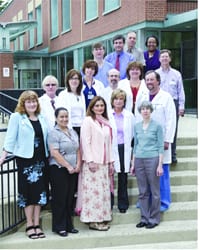Take Steps Toward Medication Safety
Both in the hospital and at home, medication errors are among the most-common mistakes we experience in medicine. The Centers for Disease Control estimates that adverse drug events cause more than 700,000 emergency-room visits and 120,000 hospitalizations each year. Such errors are costly and too common; some end in tragedy. Many, however, are preventable.
The reasons why medication errors happen are many and varied. For one thing, patients are taking more medications than ever. Current estimates are that 82{06cf2b9696b159f874511d23dbc893eb1ac83014175ed30550cfff22781411e5} of Americans take at least one prescription medication, and 29{06cf2b9696b159f874511d23dbc893eb1ac83014175ed30550cfff22781411e5} take five or more. That’s likely to continue: the nation’s population is aging, chronic diseases such as diabetes and arthritis are rising, new medicines are constantly being developed, and huge amounts of advertising — for both prescription and over-the-counter drugs — reach consumers directly, creating interest and demand for a wide variety of remedies.
Other factors contributing to errors include patient confusion or misunderstanding in taking medicines, drugs with similar-sounding names, and drug interactions with other medicines, alcohol, or certain foods.
The amount of drugs, medicines, and supplements available to patients today is enormous. Pharmacies are filled with scores of over-the-counter medicines, in different dosages and formulations. The number of commonly prescribed prescription medicines is vast (more than 1,100, according to Physicians’ Desk Reference, a commercially published volume of information on drugs), and herbal medicines and vitamins — many touted as alternative or preventive remedies — are readily accessible.
Technological advances such as electronic prescribing help to reduce errors, but e-prescribing is not yet universally used, and it doesn’t capture products we buy over-the-counter, many of which can be quite potent.
The important thing to remember — one that bears repeating — is that many medication errors are preventable. Here are steps to take for the safe use of medications.
Ask questions. When prescribed a medicine, ask lots of questions. Why is this being prescribed? How long must I take it? Are there side effects? Will it interfere with other medications I’m taking? Do I really need this, or would another treatment work?
Read the information. Each prescription comes with information, containing a description of the medicine, how and when (with or without food, how many times a day) to take it, cautionary advice, and possible side effects. Read it carefully. Do the same for over-the-counter medicines.
Keep a list. Record each medicine you take regularly, including frequency, amounts, and why you’re taking it. Keep this list up to date and with you at all times. It’s a tool that could prevent harm and save your life.
List them all. Include over-the-counter medicines, herbals, and vitamins on your med list and in discussions with your physicians and pharmacist. Some of these can interact with prescription medications or certain foods.
Share information. Bring your list to every doctor’s visit. All your physicians (and pharmacist) should know everything you’re taking. This will help to avoid adverse interactions if you’re prescribed a new medication.
Befriend a pharmacist. Pharmacists are a critical part of medication safety and an important source of information about prescriptions and over-the-counter medicines.
Supervise young and old. Be extra-attentive with children and the elderly. Adults 65 and older are twice as likely to visit an emergency department for an adverse drug event, and some 53,000 children under 5 wind up in the ER due to unsupervised ingestions of medicines.
Check the bag. Whenever you get a prescription filled, check before you leave the pharmacy to make sure it’s what the physician prescribed.
Follow instructions. If you don’t take the medicine when and how you should, not only could problems occur, but you also won’t get the full benefits from it.
Medication safety is a team sport, with the physician, pharmacist, and patient all playing key roles. The patient, however, as the last link in the chain and the ultimate consumer, must be extra-vigilant.
Dr. Mary Anna Sullivan is president of the Massachusetts Coalition for the Prevention of Medical Errors and chair of the Department of Psychiatry and Chief Quality and Safety Officer at Lahey Clinic in Burlington, Mass. This article is a service of the Massachusetts Medical Society.



Comments are closed.